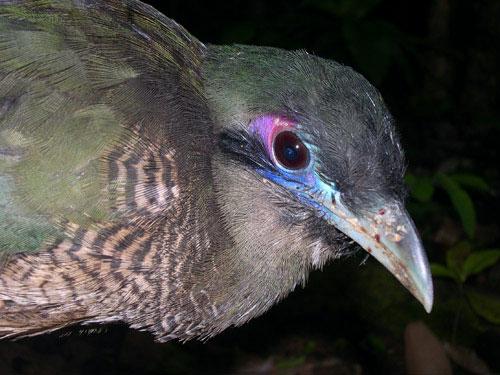|
Sumatran Ground-cuckoo (Carpococcyx viridis) - Wiki
| 제목: | Sumatran Ground-cuckoo (Carpococcyx viridis) - Wiki
| |

| 해상도: 500x375
파일크기: 37963 Bytes
등록시간: 2008:01:03 11:08:02
|
Sumatran Ground-cuckoo
From Wikipedia, the free encyclopedia
Family: Cuculidae
Genus: Carpococcyx
[Photo] Sumatran Ground-cuckoo (Carpococcyx viridis). The bird has delicate green feathers, and is on the World Conservation Union's Red List of endangered species (Image: WCS Indonesia)
The Sumatran Ground Cuckoo, Carpococcyx viridis is a large, up to 55cm long, long-tailed terrestrial cuckoo. It has a green upperparts plumage with black crown, green bill and legs, bluish green bare orbital skin and brown below.
An Indonesian endemic, the Sumatran Ground Cuckoo is distributed to rainforests of southern Sumatra. Before it was rediscovered and photographed in 1997, this elusive species was known only from eight specimens.
In 2006, a camera-trap surveying for tigers close to Kerinci Seblat National Park took an image of the Sumatran Ground Cuckoo, only the second time it had been recorded in the last ninety years. The current population is estimated at less than 250.
In 2007, its call was recorded for the first time according to New York-based Wildlife Conservation Society in a statement released February 26. The call, described as a two-syllable shriek, was recorded by WCS biologists after a trapper handed them a bird he had caught.
Due to ongoing habitat loss and small population size, the Sumatran Ground Cuckoo is evaluated as Critically Endangered on the IUCN Red List of Threatened Species.
http://en.wikipedia.org/wiki/Sumatran_Ground-cuckoo
| The text in this page is based on the copyrighted Wikipedia article shown in above URL. It is used under the GNU Free Documentation License. You may redistribute it, verbatim or modified, providing that you comply with the terms of the GFDL. |
|
^o^
동물그림창고 똑똑전화 누리집
^o^
|
|